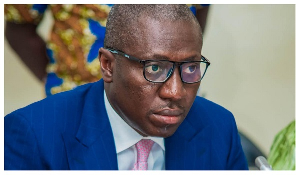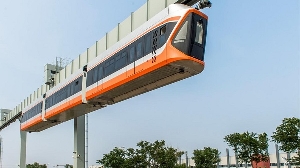Everybody has insulted ECG. Called the customer service and complained. Cursed them for destroying an appliance. Twisted and turned in a pool of sweat in your bed, the only wind being the mosquitoes buzzing by your ears. Everybody has his or her own ECG story.
Personally, I was interested in the story of how the situation came to be like this, the story of our national grid. So I conducted a research for my master thesis, breaking down the lifespan of our national grid to 3 distinct eras based on the dominating fuel supply. That is Hydro Era, Thermal Complement and Thermal Dominance. Finally, I considered the possibilities of solar energy as potentially being the next fuel to power our national grid.
Hydro Era
On March 6th 1957, Ghana gained political independence amid a wash of patriotism, jubilation and belief. President Nkrumah’s political ideology shaped his strategy for achieving economic development, that is, a centralized state garnering the nation’s resources towards rapid industrialization with the replacement of imported goods key to the goal of achieving economic independence. At the heart of this plan was securing a readily available source of electricity to spur industrialization. Thus, the Volta River Project was created and subsequently the Volta River Authority (VRA).
The development of the Akosombo hydroelectric dam on the Volta basin is really the beginning of this story. The dam needed to be built as a storage for water, since the flows of the Volta river fluctuated wildly during the year. The dam needed to supply a readily available and constant flow of electricity for its main off-taker, VALCO, who enjoyed extremely low rates at Ghana’s expense. These low rates persisted through the political turmoil that ensued after Nkrumah’s overthrow. The other occurrence was the unforeseen regional shift in rainfall regime across West Africa over the late 1970s leading to the devastating drought of 1983. It was after these incidents of low rainfall which resulted in low productivity of the Akosombo dam that VRA, the governing body responsible for supply, decided to plan for a thermal complement for the electricity supply to the grid.
Thermal Complement
In comes Rawlings with his 1979 and 1981 revolutions and the fervor from it would lead to the renegotiation of the VALCO agreement in 1985, paving the way for cheap electricity to be made available to ECG’s growing customer base.
By the end of the 1980s, Ghana’s economic recovery along with a more stable political environment paved the path to democracy for Ghana which was delivered in 1992 with the election of Rawlings and the National Democratic Congress (NDC).
With democracy came a rigorous decentralization program across multiple sectors of the economy, which manifested in the form of the Statutory Commissions act. This impacted the electricity sector by transforming the Electricity Corporation of Ghana to Electricity Company of Ghana (ECG), the creation of separate price regulatory body in the PURC and further plans to deregulate the centralized state utilities. These changes were a combination of IMF directive and government initiative to free up funds for VRA to develop thermal power plants, which had been part of the plan since the drought of 1983, and following droughts of 1994. Thus, in 1997 and 1999 TAPCO and TICO were built respectively, with TICO being the first power plant co-owned by an independent power producer (IPP).
This is where the trouble ignites. What we have at this point is:
(1) an electricity supply system still dependent on the hydroelectricity from Akosombo (over 60%), and therefore the Volta basin fluctuating rainfall regime, and a thermal complement dependent on expensive crude oil.
(2) a growing ECG customer base used to cheap electricity from the Akosombo, and a price regulatory body (PURC), relatively independent, but still heavily influenced by the President’s office.
(3) a democratically elected government keen on pleasing the populace to remain seated as incumbent.
It is an almost perfect storm. So what happens is that, the government keeps electricity prices artificially low so as not to disturb the electorate, and the state-owned utilities (ECG in particular) suffer because they aren’t receiving enough money to cover their operations nor purchase electricity* (* Even with PURC’s 400% increase in tariffs in 2001 it was still well below the VRA and ECG prescribed prices (Yakubu, 2002), not only from VRA’s hydroelectricity but for the crude oil now being imported to power the thermal power plants.
It is a cascade effect. So VRA provides electricity to ECG to serve a growing customer base, and ECG receives not enough to pay back to VRA for the electricity. It is a devastating loop which creates feedbacks in the form of a financially constrained utility company. The final component of the perfect storm arrives in the form of reduced production from Akosombo due to poor rainfalls of 1999, consequently sparking a nationwide electricity crisis.
Compounding the new period of low rainfall was the underutilized thermal power plants due to increased price of crude, but plans were underway to convert the plants to use gas as well. This didn’t prevent the 2006-2007 electricity crisis. The estimated cost of the power crisis to GDP was 1.5% (Amoako-Tuffour & Asamoah,2015).
Thermal Dominance
As a response to the 2006-2007 electricity crisis a number of thermal power plants were built, mainly in Tema, creating a cluster (TT1PP, TT2PP). But the problem of expensive crude was still hampering Ghana’s balance of payments and socio-economic development as the state’s purse was devastated by importing crude which had shot up in price prior to and during the global financial crash.
But then oil and gas was discovered!
So instead, gas was to be used to power the thermal plants and additional gas was to be made available through the West African Gas Pipeline from Nigeria, which had been in the works for over 10 years. Sunon-Asogli a majority Chinese owned firm, built another power plant in Tema based on what was expected to be readily available domestic gas, and fortunately the Volta basins hydrology was kinder to Ghana reducing need for crude imports.
However we need to clarify other factors that have been going on alongside these developments:
Rapid urbanization over the course of the democratic period increased the number of customers the ECG serviced but tariffs remain uneconomic
The nature of the economy’s development was also problematic since the fastest growing categories of users were the service sector and domestic, meaning that the electricity being used wasn’t necessarily productive - and in fact the issue of uneconomic tariffs, inadequate revenue collection, and cash flow was causing further damage to the financial situation of the utilities
It became immediately apparent that Ghana’s gas reserves were not large enough (approx. 300 mmscfd below expected demand in 2020 even if full supply was tapped) to alleviate the need to import large amounts of crude oil (Energy Commission Energy Outlook 2017).
And none of Ghana’s power plants that supplied the grid were running at full capacity, either hydroelectric or thermal.
The lack of fuel from either Ghana’s gas reserves or expensive crude would eventually spark the most recent power crisis aka ‘dumsor.’ At this point President Mahama had been elected in the wake of Atta-Mills’ death in 2012. As we see the perfect storm from the previous electricity crisis had only been put on hold, and with the new storm came a more devastating blow to the socio-economy, estimated at around $320 million lost per year since 2008 (Amoako-Tuffour & Asamoah, 2015). At this stage, electricity was almost ubiquitous with economic growth, and seeing that the Mahama administration was unable to secure fuels for the power plants, it added to other issues which eventually saw his administration lose the 2016 election to Nana Akufo-Addo.
The situation has stabilized to an extent, but our electricity supply still remains largely dependent on unsecured fuel resources.
Solar Era
Despite the problems of with large scale solar there is still hope and it comes with marrying the current capacity of solar with consumers ready to pay the right price for electricity and financial institutions ready to back the high costs of installations. Recently, the African Guarantee Fund held a capacity development workshop for members of the banking community informing them of their readiness to guarantee clean energy related projects, reducing the risks for investors and therefore eliminating a current bottleneck. Also, big electricity consuming companies are taking the first steps to going off-grid by installing solar systems and arranging power purchase agreements with the contractors, since ECG’s high tariffs and unreliable supply are making costs of operations unsustainable.
Opportunities abound across the country. For instance, the ‘one district, one factory’ initiative is a perfect opportunity to establish smaller scale versions of what Akosombo was to VALCO. That is, setting up a solar plant and having the factory agree a power purchasing agreement so that electricity is guaranteed for the plant’s operations.
There has already been a substantial increase in solar installations in Ghana. From schools around the country like Jack and Jill to Accra Girls, to hospitals like Family Health Hospital at Nungua to multiple residential and commercial installations and finally to other applications like the solar-pump, solar is gaining prominence in the Ghanaian imagination. These are just some of the indications that a massive tide of solar installations are about to wash over the country.
The question now, is how effectively can we use it to power our socio-economic development?
Opinions of Thursday, 29 March 2018
Columnist: Abdallah Smith















